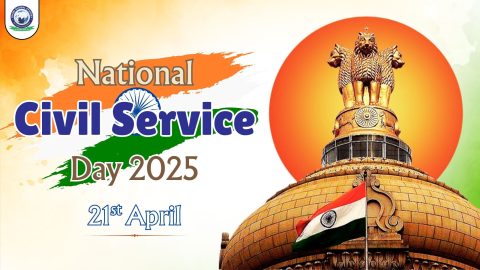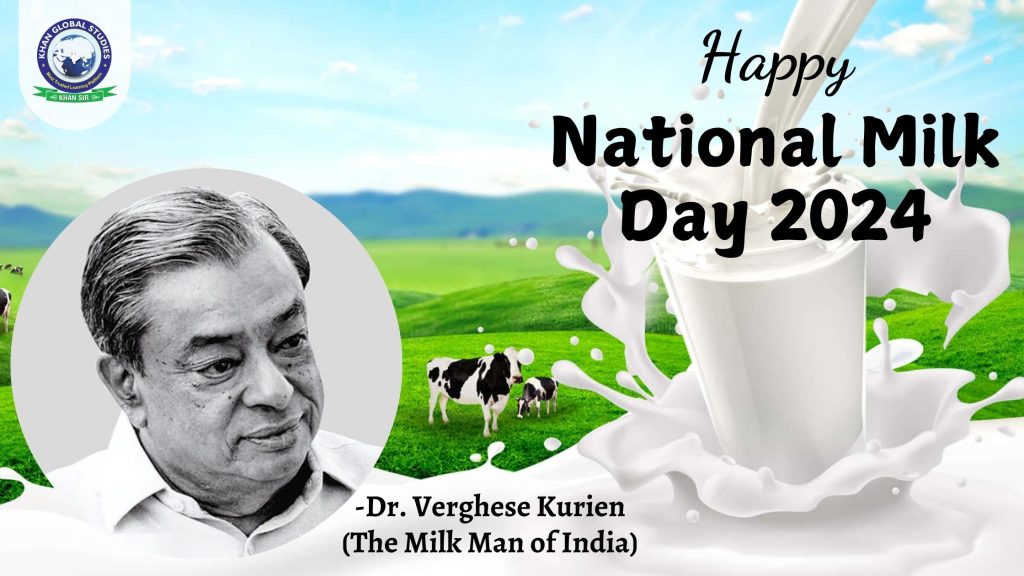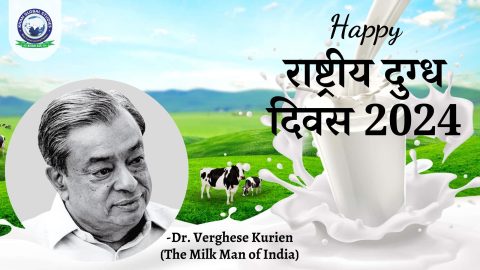National Milk Day, which is celebrated every year on November 26, is a tribute to Dr. Verghese Kurien, who is known as the “Father of India’s White Revolution”. His unprecedented efforts transformed India from a milk-deficient country to the world’s largest milk producer. This important day highlights the contribution of the dairy industry in boosting rural livelihoods, promoting economic growth, and providing nutrition to millions of people.
Origin and Significance of National Milk Day
The celebration of National Milk Day was initiated by the Indian Dairy Association (IDA) in 2014 to commemorate the birth anniversary of Dr. Kurien. It emphasizes the important role of milk not only as an essential food item but also as an economic driver. Through the cooperative dairy model, millions of farmers, including a large number of women, have found sustainable livelihoods.
Dr. Kurien’s vision, which was realized through Operation Flood launched in 1970, marked the beginning of India’s White Revolution. This initiative created a national milk grid that linked rural dairy farmers to urban markets, ensuring fair prices and better incomes for farmers. Over the years, India has become a global dairy powerhouse, producing 25% of the world’s milk.
India’s White Revolution: A Historical Milestone
India’s White Revolution was a game-changer, making the country the largest producer of milk worldwide. When the program began in 1970, India’s annual milk production was a modest 20 million tonnes. By 2011, this figure rose to 122 million tonnes, reflecting the immense success of the revolution.
The foundation of this transformation lay in the creation of cooperatives like AMUL (Anand Milk Union Limited). These cooperatives empowered farmers by providing them ownership, fair prices, and direct access to markets. Today, there are over 1.94 lakh dairy cooperatives in the country, supporting nearly 80 million small farmers and contributing significantly to rural prosperity.
Government Initiatives Promoting Dairy Development
The continued support extended to the dairy sector by the Government of India has played a vital role in its growth. Several programmes and schemes have been implemented to strengthen the industry:
- Rashtriya Gokul Mission: Focuses on the conservation of native cattle breeds.
- Dairy Entrepreneurship Development Scheme: Supports small-scale dairy entrepreneurs with financial and infrastructural assistance.
- National Dairy Development Programme: Improves milk processing and marketing infrastructure.
- Animal Husbandry Infrastructure Development Fund: Encourages private investment in dairy infrastructure.
- Kisan Credit Card Scheme: Provides easy loans to dairy farmers to expand their operations.
These initiatives have strengthened the dairy sector, making it a cornerstone of India’s rural economy.
Dr. Verghese Kurien: Architect of the White Revolution
Dr. Verghese Kurien’s unique contribution to India’s dairy industry earned him the title of “Milkman of India”. His visionary leadership in founding Amul and initiating Operation Flood laid the foundation for India’s dairy revolution. Dr. Kurien championed the idea of farmer-led cooperatives, ensuring that those who produce milk reap its economic benefits. His legacy inspires efforts towards rural empowerment and self-reliance.
Nutritional Importance of Milk
Milk is often viewed as a nutritional powerhouse, providing a rich range of nutrients essential for Human Health:
- Calcium: Strengthens bones and teeth.
- Protein: Aids muscle growth, repair, and overall development.
- B-vitamins: Aid energy metabolism and maintain healthy skin and hair.
- Potassium: Regulates blood pressure and promotes heart health.
Milk’s high-quality proteins contain essential amino acids, which are important for growth and repair but cannot be produced by the body. For children, milk is indispensable, supporting physical and cognitive development. The inclusion of milk in the daily diet ensures holistic well-being across all age groups.
Sustainable Dairy Farming: A Balanced Approach
Sustainability in dairy farming is imperative to balance economic growth with environmental protection. Indian dairy farmers are increasingly adopting eco-friendly practices, such as:
- Efficient water management: Techniques such as drip irrigation and water recycling reduce water wastage.
- Biogas production: Using cattle dung to generate renewable energy and reduce greenhouse gas emissions.
- Natural farming practices: Promoting organic feed and reducing reliance on chemical inputs.
These measures contribute to long-term environmental sustainability and align with global efforts to combat climate change.
India’s Dairy Industry: The Global Leader
India’s dairy industry stands as a beacon of success, accounting for 25% of global milk production. In the last decade, milk production has increased by 58%, reflecting the robust growth of the industry. India not only meets domestic demand but also exports dairy products across the world, increasing its global stature.
The success of the Indian dairy sector lies in its ability to combine traditional practices with modern technology, ensuring high-quality milk production while supporting millions of rural livelihoods.
Milk in Indian Culture: A Culinary Staple
Milk has been an integral part of Indian culture for centuries, celebrated in traditional dishes and rituals. Its versatility is evident from its widespread use in households:
- Ghee and Paneer: These staple foods, usually made at home using fresh milk, are essential in Indian cuisine.
- Milk-based desserts: From kheer to rasgullas, milk is the main ingredient in many traditional desserts, often prepared during festivals like Diwali and Holi.
This cultural significance underlines the irreplaceable role of milk in Indian households.
Health Benefits of Milk
The health benefits of milk are numerous, making it the basis of a balanced diet:
- Bone Health: Rich in calcium and protein, milk promotes strong and healthy bones.
- Immunity Support: The nutrients present in milk boost the body’s immunity, protecting against infections.
- Muscle Recovery: The high-quality protein present in milk aids in muscle growth and repair, making it ideal for athletes and growing children.
For children, consuming milk daily aids in their physical and mental development, preparing them for a healthy future.
Celebrating National Milk Day: A Reminder of the Importance of Milk
National Milk Day is more than a commemoration; It is a celebration of the role milk plays in shaping India’s economy, health and culture. As we honour the contributions of Dr. Verghese Kurien, we also recognize the importance of sustainable dairy farming and the enormous potential of India’s dairy industry.
Conclusion
National Milk Day is not just a celebration of milk; it is a tribute to the people and processes that bring this essential food to our table. It underscores the role of milk in promoting health, economic stability, and cultural traditions. As we celebrate this day, it is an opportunity to appreciate the hard work of dairy farmers and commit to sustainable consumption practices.
Frequently Asked Questions
Q: Why is National Milk Day celebrated on November 26 in India?
Ans: It is celebrated to commemorate the birth anniversary of Dr. Verghese Kurien, the “Father of the White Revolution”, who made India the largest producer of milk.
Q: What are the health benefits of milk?
Ans: Milk is rich in calcium, protein, and vitamins B12 and D, which are essential for strong bones, muscle repair, and overall health.
Q: How can we celebrate National Milk Day?
Ans: You can celebrate it by consuming milk or dairy products, educating others about its benefits, or supporting local dairy farmers.
Q: Is there a global date for National Milk Day?
Ans: Although there is no universal date, the Food and Agriculture Organization celebrates World Milk Day every year on June 1.
Q: Are there any challenges in the dairy industry?
Ans: Yes, challenges include sustainability issues, the impact of climate change, and ensuring fair wages for farmers.




